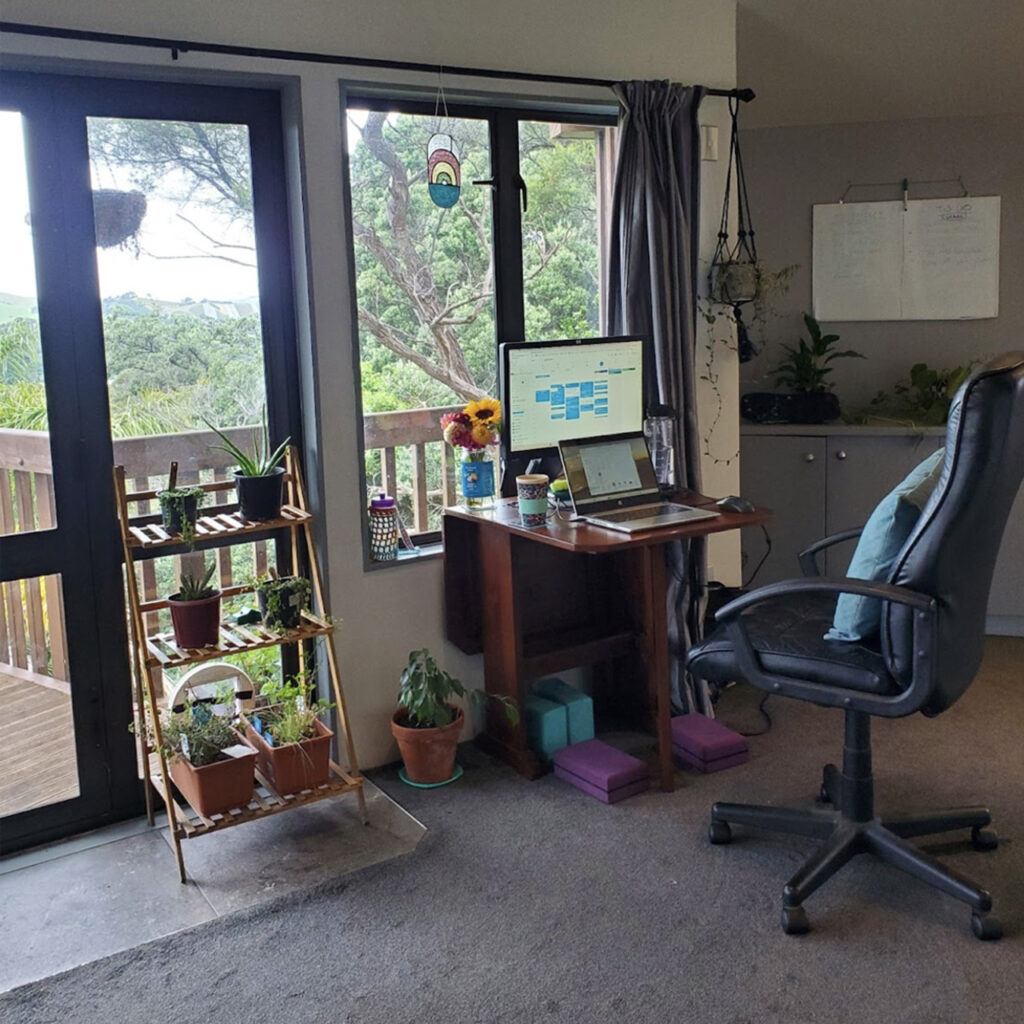Working from home can have considerable sustainability benefits: no commute means less vehicles on the road, which reduces emissions, traffic, and microplastics from tyre wear, and more people working from home means less office energy use and less takeaway coffee cups and food packaging. The trade off, however, is that remote work can lead to people increasing their environmental impact at home (e.g. it requires more energy to heat or cool a dozen separate home offices than one 12-person office), and it can also be challenging in terms of maintaining a healthy balance between our personal and professional lives. This blog is a simple guide to help you understand your biggest impact areas and how to work sustainably from home.
Cut down on what you send to landfill
Much of what kiwis send to landfill each year could be reused, repaired, recycled, or composted; MfE estimates that 39% of our landfill composition is made up of organics, 19% paper, and 4% metal. To cut down on the materials you send to landfill, you can:
- Reduce the amount of food you dispose of. According to LoveFoodHateWaste, the average kiwi household throws out a whopping $1,520 worth of food per year. The food we’re tossing out is bad for our wallets and bad for the environment, as organic matter in landfills creates methane, a powerful greenhouse gas that drives climate change, and it also stop the cycle of life that sees nutrients returned to our soil. We can avoid throwing out usable food by planning meals, keeping an eye on expiry dates, storing food correctly, and eating our leftovers; explore LoveFoodHateWaste for lots more practical tips to avoid food waste.
- Set up a home composting system. When dealing with inedible food scraps, composting or vermicomposting (worm farms) is key to keeping precious organic nutrients out of landfill and cycling them back into our soil. If you don’t have access to a kerbside compost collection, consider how you might be able to compost at home. LoveFoodHateWaste has a great guide on how to set up your own compost or worm farm, or Bokashi bins offer an easy alternative to traditional compost bins. If you don’t have a garden or the capabilities to compost at home, check out ShareWaste to see if anyone in your neighbourhood is accepting compost, or see if there are any local community gardens accepting organic drop offs, like Kelmarna Gardens in Auckland. If you’re interested in the process and benefits of composting, read more on our website.
- Explore ways to reuse, repurpose, or repair. Before throwing something away, consider whether it could be reused or given a new life through repurposing. For example, old clothes can become cleaning rags or pet beds, jars can become storage containers, and cans and other containers can become plant pots. Try to eliminate disposable items from your home, swapping things like paper towels for reusable cloths. If an item is broken, investigate local businesses who might be able to help you repair it. Repair Cafés are free, pop-up events where people can bring in broken items and local volunteers will help them try to fix it; check the RCANZ website to see if there are any upcoming cafés happening in your area. Unwanted but functional items can be donated to secondhand stores or sold through online secondhand markets like TradeMe, which offers a courier service that picks up items from your home.
- Recycle right. If you do need to dispose of something, make you know whether it’s recyclable and, if so, how to recycle it correctly. Putting the wrong item in your recycling, or an item that is contaminated, has huge implications for the whole recycling system. Check your local council website for guidance on what can go into your kerbside recycling, and look for additional recycling programmes in your community, such as soft plastic recycling, polystyrene recycling, or battery recycling at participating stores. Set up collections for different streams and make sure your household is familiar with what goes where.
- Remove desk bins. If you keep a bin near your workspace, remove it to avoid the temptation to dispose all of your materials into the same place. Not having an easily accessible bin will also encourage you to get up and move around.

Minimise energy use
Working from home means using more energy to power your computer, light your work space, and keep it warm. Make sure your home is as energy efficient as possible and that you’re avoiding unnecessary energy use – both for the planet, and for your electricity bill!
- Choose a green energy supplier. In New Zealand, we’re lucky enough to receive the majority of our energy from renewable resources, however, some providers offer a higher percentage of renewable energy than others. One example is Ecotricity, which provides 100% renewable energy and is Toitū net Climate Positive certified.
- Use daylight and energy efficient light bulbs. Make the most of natural light to illuminate your work space. When using lights, opt for LED bulbs, as they are more energy efficient and have a considerably longer lifespan than traditional light bulbs.
- Increase heating efficiency. Natural light can help illuminate your workspace, and it can also heat your home. Trim back trees and foliage to let the sun shine in. Check whether your home has underfloor and ceiling insulation and opt for more efficient heating options, like heat pumps, where possible. Ventilate your home for at least half an hour each day by opening windows, as less energy is required to heat cold, dry air than to heat warm, damp air.
- Cut back on hot water. According to GenLess, around 30% of the household energy use is from hot water. Reduce hot water use by washing your clothes with cold water, taking shorter showers (cold ones if you’re brave!), and only running your dishwasher when it’s full.
- Switch off devices not in use. Make sure to power off your work device at the end of the day and switch it off at the wall. Not only does this save power, but it also helps signal to yourself that your work day is over.
Take care of your wellbeing
A big part of creating a sustainable work environment it taking care of your health and wellbeing. It can be challenging when the lines between work and home blur, so try to create boundaries between your work life and personal life.
- Maintain a regular work schedule. Consistency in your schedule in your work office and home office can help you maintain focus and reduce stress. Try to follow your normal work and sleep patterns, and make sure to stop working when your workday is over. It can help to sart and end your workday with a routine, like journaling or taking a walk, to highlight to yourself that your workday is beginning or ending.
- Have a dedicated work space. Creating a space specifically designed for work can help you create a healthy mental boundary. Where possible, pick a quiet space away from distractions, and separate this area using things like plants or a screen. Make sure the space is comfortable and safe; WorkSafe has a detailed guide on how to set up a healthy work station. Personalise your space with things like photos or plants to make it an extra enjoyable spot to work from.
- Set ground rules with others in your household. If you share your home, discuss with your housemates how best to accommodate one another. Set ‘do not disturb’ times, and have volume limits on noise from things like speakers and TVs. If you have young kids, create a family timetable together and make it visible for everyone as a reminder. Plan for interruptions and don’t beat yourself up about it!
- Stay connected with your team. Office banter is good for more than just a laugh, it helps teams feel connected and comfortable with one another. It’s important to stay consciously connected with your colleagues, which you can do through arranging regular video check ins, figuring out a preferred messaging platforms, and arranging days to work or socialise in person together.
- Give yourself a break! (Literally and figuratively). With so many distractions (and so much food) at your fingertips, working from home can be super challenging. Be kind to yourself if you’re struggling to focus, especially if you’ve got young kids to work around. Give yourself proper lunch and screen breaks, get outside into nature if you can, and consider using the time you save on your commute to exercise or do a mindfulness activity.
Written by Kate Lodge, Sustainability Consultant at Go Well Consulting
(Featured image by Theo from Pexels)

